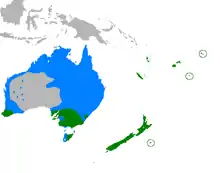Swamp harrier
The swamp harrier (Circus approximans) - also known as the Australasian marsh harrier, Australasian harrier, or swamp-hawk - is a large, slim bird of prey widely distributed across Australasia. In New Zealand it is also known as the harrier hawk, or by the Māori name kāhu. Its arrival in New Zealand happened recently within the last 700 years, replacing its extinct larger New Zealand endemic sister species Eyles's harrier.
| Swamp harrier | |
|---|---|
.jpg.webp) | |
| Adult female swamp harrier with a hare | |
| Scientific classification | |
| Kingdom: | Animalia |
| Phylum: | Chordata |
| Class: | Aves |
| Order: | Accipitriformes |
| Family: | Accipitridae |
| Genus: | Circus Lacépède, 1799 |
| Species: | C. approximans |
| Binomial name | |
| Circus approximans Peale, 1848 | |
 | |
The swamp harrier belongs to the sub-family Circinae and genus Circus, which are represented worldwide, except Antarctica. The sub-family and genus are derived from the characteristic behavior of circling flight during courtship and hawking.
Description
The swamp harrier is largely dark brown, becoming lighter with age, and has a distinct white rump. It hunts by flying slowly, low to the ground, on upswept wings. The body length is 48 to 62 cm (19 to 24.5 in), and the wingspan is 118 to 145 cm (3 ft 10 in to 4 ft 9 in). The recorded weights of adults range from 580 to 1,100 g (1.28 to 2.43 lb). Females are significantly larger than the males. In New Zealand, 54 males averaged 640 g (1.41 lb) and 66 females averaged 870 g (1.92 lb). Going on mean weights and linear measurements, the swamp harrier may be by a slight margin the largest extant species of harrier but it is only marginally larger than some other species, like the marsh harriers and the Reunion harrier.[2][3][4]
 Adult male soaring in flight
Adult male soaring in flight Immature flying in Victoria, Australia
Immature flying in Victoria, Australia
Distribution and habitat
The swamp harrier is widespread through Australasia and many islands in the south-west Pacific region, including much of Australia (except the arid region), New Zealand (where it is common in open country),[5] Fiji, Vanuatu, New Caledonia and as stragglers on some subantarctic islands.[6] It is usually found in wetlands and well-watered open country.
The harrier only became established in New Zealand within the last few hundred years, after lowland forests were extensively cleared by the first Polynesian settlers; it is absent from the fossil record.[7] It has benefited from European settlement, and is now very common, especially in open farmland.[8]
Behaviour
Common enemies of harriers are Australian magpies, masked lapwings which dive bomb and European starlings which mob individuals. They have been known to kill young kārearea and have also been heavily blamed and persecuted for killing chickens, pheasants and ducklings. Swamp harriers are the only bird of prey used for falconry in New Zealand;[9] quarry is usually pukeko and young rabbits.
Diet
The swamp harrier mainly feeds on ground birds and waterbirds, rabbits and other small mammals, reptiles, frogs, and fish. During the winter months harriers feed to a large extent on carrion, including roadkill, frequently falling victim to vehicles themselves.
Breeding
This species nests on the ground, often in swamps, on a mound in reeds or other dense vegetation. In some districts they nest in fields of oats or barley.[10] The clutch size may range from two to seven, but is usually three or four. The incubation period is 31 to 34 days, and is carried out by the female alone. Chicks are fed by both parents, are fully feathered by 28 days and fledging about 45 days after hatching.
See also
- Kārearea, or New Zealand falcon
Notes
- BirdLife International (2012). "Circus approximans". IUCN Red List of Threatened Species. 2012. Retrieved 26 November 2013.CS1 maint: ref=harv (link)
- Ferguson-Lees, J., & Christie, D. A. (2001). Raptors of the world. A&C Black.
- Dunning Jr, J. B. (2007). CRC Handbook of Avian Body Masses. CRC Press.
- Simpson, K., & Day, N. (1984). The Birds of Australia: A Book of Identification: 758 Birds in Colour. L. O'Neil.
- Heather, Barrie; Robertson, Hugh (2005). The field guide to the birds of New Zealand. North Shore, New Zealand: Penguin. p. 275. ISBN 978-0-14-302040-0.
- A Guide to Canterbury Museum's Edgar Stead Hall of New Zealand Birds
- Worthy, Trevor H.; Holdaway, Richard N. (2002). The lost world of the moa : prehistoric life of New Zealand. Bloomington: Indiana University Press. ISBN 0-253-34034-9. OCLC 46634728.
- Seaton, R.; Galbraith, M.; Hyde, N. 2013. Swamp harrier. In Miskelly, C.M. (ed.) New Zealand Birds Online. www.nzbirdsonline.org.nz
- "Which Birds Of Prey Are Available To NZ Falconers?". wingspan.co.nz. Retrieved 19 March 2020.
- A Guide to Canterbury Museum's Edgar Stead Hall of New Zealand Birds
References
- BirdLife International (2006). Species factsheet: Circus approximans. Downloaded from http://www.birdlife.org on 4/12/2006
- Marchant, S.; & Higgins, P. J. (eds.). Handbook of Australian, New Zealand and Antarctic Birds. Vol. 2: Raptors to Lapwings. Oxford University Press: Melbourne. ISBN 0-19-553069-1.
External links
| Wikimedia Commons has media related to Circus approximans. |
| Wikispecies has information related to Circus approximans. |
- Wingspan Birds of Prey Trust - The national centre for the conservation, education and advocacy of birds of prey in New Zealand. Location: Rotorua, NZ

